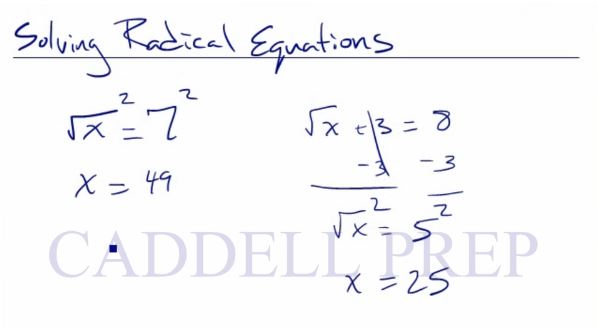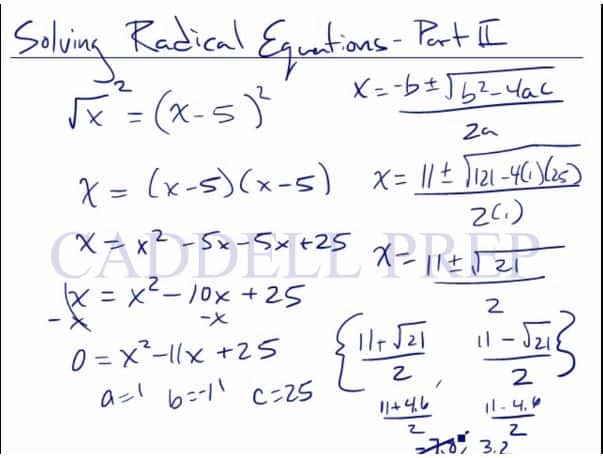Part 1
In this video, we are going to solve equations with a radical expression. After you finish this lesson, view all of our Algebra 1 lessons and practice problems.
In , first square both sides of the equation
If there are other values in the equation, then first isolate the before squaring both sides of the equation.
Video-Lesson Transcript
Let’s go over how to solve equations with a radical expression.
We have
In order to solve for , we have to get rid of the radical sign.
The inverse of a square root is squaring.
So we’ll square both sides
If we have something like this:
we want to get the radical by itself first.
Let’s subtract on both sides
And the last step is to square both sides.

Let’s look at a more complicated one
Again, we want to have the radical by itself. Let’s add on both sides.
Let’s have this:
Here, the whole term is under the radical, so it is already isolated.
So, we’ll start by squaring both sides.
Now, let’s solve for .
Part 2
In the second part, we are going to solve equations with a radical expression that are more complex.
For example:
Square both sides of the equation
Use FOIL to complete the squaring if necessary
Since it’s a quadratic equation, use the quadratic formula
Substitute the variables
So we have:
and
In the end, x is approximately 7.8 or 3.2
If it was -7.8 instead of 7.8, then it cannot be a negative answer since the square root of a negative number is imaginary. In this case, the final answer would just be 3.2.
Examples of Solving Equations That Have Radical Terms
Example 1
First, square both sides of the equation to eliminate the radical symbol
Then, solve the equation that comes out after the squaring process
Get all the terms on one side so the other side be zero.
Now, we can factor out the quadratic function
Let’s solve for
and
The answers are
Example 2
First, add -1 from both sides
Now, we square both sides of the equation to eliminate the radical symbol
Then, solve the equation that comes out after the squaring process
Get all the terms on one side so the other side be zero.
Now, we can factor out the quadratic function
Let’s solve for
and
Remember: if one of the answers come out as a negative, that’s a rejected answer.
Therefore, our final answer is
Video-Lesson Transcript
This is how to solve equations with a radical expression part 2.
It’s a little bit different because we have on both sides.
Here, we want to get the radical by itself first before we combine the together.
In order to get rid of the radical, let’s square both sides.
Now, we have a quadratic equation.
We want to get all the terms on one side so the other side be zero.
This can not be factored so let’s just use the quadratic function to solve it.
Our formula is
Here we have
Our answers are
{}
What is important here is that we always want to make sure that we won’t end up with a negative radical.
Let’s find out what is the exact value of this is
If one of the answers come out as a negative, that’s a rejected answer.
The only answer we accept is a positive number. Because you cannot find the square root of a negative number.
So, you always have to check and make sure that you don’t have a negative number under the radical. After you finish this lesson, view all of our Algebra 1 lessons and practice problems.



